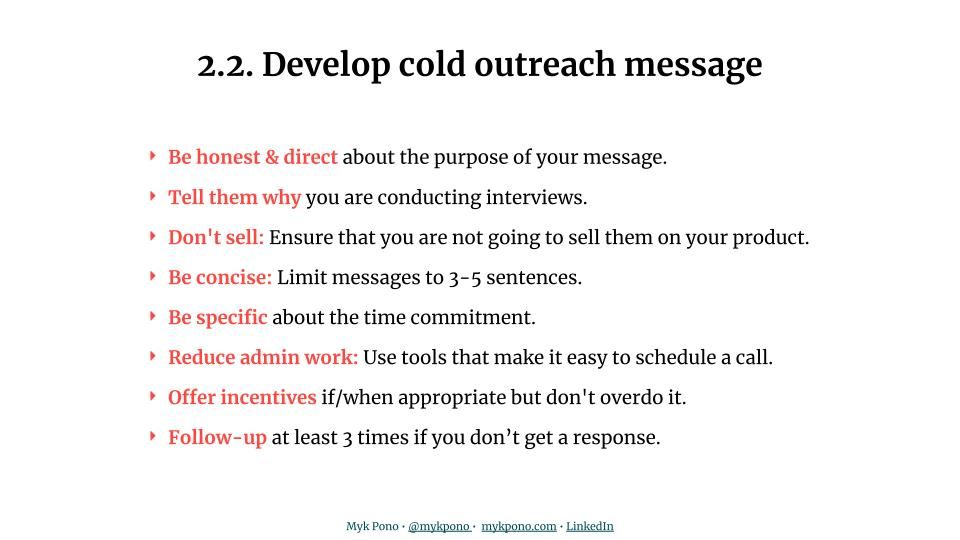Course 2.2: Customer Interviews | Building Your Cold Outreach Strategy

Updated: https://lab.mykpono.com/free-course-Customer-User-Interviews-13cbee28614780feb9b9fbe594eb145c
2.2. Building Your Cold Outreach Strategy
You might be thinking -- 200 potential subjects? This is going to take a while.
Don’t worry! In this video, you will learn the perfect COLD OUTREACH STRATEGY so that you save time and get the most out of your outreach.
Start with LinkedIn. Only move onto email if the potential subject doesn’t respond or if they don’t have a LinkedIn profile.
Here’s what my cold outreach strategy looks like for LinkedIn:
- First, I send them a custom connection request with a custom message included.
- If they do not accept the connection request, I send a LinkedIn InMail to follow up. InMail is a Premium Feature. If you don’t have InMail, instead send a direct email to the potential subject using this script: “I’ve tried to connect with you on LinkedIn…”.
- If they DO accept the connection request, I send them a quick follow-up message right away that reiterates why I want to talk to them.
- What if they accept the connection request, but don’t respond to my message?
In this case, I’ll wait a couple of days and send another follow-up message.
And if that still doesn’t get a response, I’ll send a final follow-up message reiterating why I want to talk, and that I’m not trying to sell them anything.
Let me show you an example of what this looks like in practice:
Message 1:
Hi NAME,
I'm a co-founder of Publishnow. We’re working on a new project over here and trying to learn more about how marketers manage the content creation and distribution process -- so that we can understand how to make it better.
Your insights would be so valuable and appreciated.
Would you be open to a quick 20-minute call?
You can see here that my first message does three things in three short sentences.
It introduces who I am. Explains why I’m reaching out and why it’s valuable to them.
Then I ask them for a very quick call. If this person is a customer, you can even start with telling them how much you appreciate having them as a customer and that you are trying to learn how you can make things even better. Whenever possible, let them know what’s in it for THEM.
If you don’t hear back in 2 days, send a follow-up message. Something like:
Message 2:
Hi NAME,
Wanted to float this to the top of your inbox. Would you be up for a 20-minute call?
Your feedback would provide valuable insights on how we could improve the content creation process for marketers like you.
As you can see, it’s even shorter. I’m recognizing they are busy and reminding them of the value of this conversation for THEM.
Most people find it rewarding to help improve something they are passionate about or help others.
If you still don’t receive a response, you can try to send one more message a couple of days later. Something like:
Message 3:
Hi NAME,
Just a quick follow-up to see if you’d be willing to share your experience in content creation and distribution.
To be clear, this is not a sales call. I’m interested in hearing about your experience in content creation and distribution. Your insights would be incredibly valuable and appreciated.
Would you be up for a quick call?
Here I’m reminding them why I’m asking for a call but also emphasizing that it’s not a sales call. Then I remind them how much I value their insights. People love to feel helpful, so this often elicits a response.
I like to use several different message variations in my follow-up sequences. They essentially ask for the same thing, but do so in different ways. With these variations, I can just rotate them throughout my follow-up sequence -- and replace those that don’t tend to get responses.
So as you get ready to start reaching out to set up customer interviews, I recommend you develop your own message templates that you can send without having to think too much about writing something new each time.
I highly recommend using scripts for this, but you still want to personalize them for every person. People will be more likely to respond if they feel like you’re reaching out to them specifically vs being included in some mass mailing.
Here are a few other tips to keep in mind as you write your own scripts:
1. Be honest and direct.
Right away, say hi, and introduce yourself. This doesn’t need to be more than a sentence, but it needs to set up why you’re reaching out to them.
2. Tell them why you’re reaching out.
Next, make it clear why you’re trying to connect. Tell them you want to have a conversation to understand their experiences or to get more information on how they go about certain processes within their organizations.
3. Don’t sell.
Remember, these are customer and prospect interviews. They aren’t about your product, or about selling your product. Be upfront that you’re not trying to sell them anything. In fact, don’t mention your product at all. Keep your messages focused on their experiences.
4. Be concise.
No one wants to read long paragraphs in an outreach message. They want to know who you are, what you’re asking, and why you’re asking it so they can determine whether or not they’re interested in helping you. As a general rule, if you’re writing more than five sentences in these messages, you’re doing it wrong.
5. Make a specific request.
When I reach out to people, I ask them for 20 minutes, and if they say yes, I’ll set the invite for 25 minutes. Most people in the professional world break things down into increments of 30 minutes. So if people commit to 20 or 25 minutes, you can often assume they’re saying yes to meeting for 30 minutes, unless they tell you otherwise. That gives you a little wiggle room to extend the interview if you need to (but don’t use that as an excuse to take advantage of them and chat for an hour).
6. Make it easy to schedule a call with you.
People will be more likely to say yes if you make it as easy as possible for them to do so. Use the tools I mentioned in the last section to send them a few specific booking options so that they can sign up with just one click.
7. Offer incentives.
This is a tricky one. It’s very easy to offer incentives, but I don’t personally like using them. I want to talk to people who are passionate about the topic and who want to share - not people who are just trying to get something in return.
Sometimes it makes sense to offer incentives, like if you’re asking for an interview that’s going to be longer than 30-minutes or if it’s necessary to get someone on the phone that you want to talk to, but that won’t do it without an incentive. But don’t overdo it with incentives. Don’t use them every time, and don’t make them so big that you invalidate the data you capture in your interviews.
8. Follow-up.
People are busy. Sometimes you have to send more than one message to get an interview booked. But, again, don’t overdo it. I see people using 15-message email sales sequences - and that might be appropriate for sales, but that’s not what you’re doing here. The Three-Message sequence is the sweet spot for me since I’m asking people to do me a favor by scheduling an interview. If you don’t get a response after three messages, leave it at that, and move on.
In the next part, we will discuss how to run your interviews.
Checklist:
Setting Your Interviews
- Conduct at least 10-20 interviews
- Determine how many potential subjects you need to reach out to book your target number of interviews
- Talk to your customer service team to identify potential subjects
- Use LinkedIn and your Ideal Customer Profiles (ICPs) to find others
- Automate reminder messages to interview subjects to limit no-shows
Booking Interviews with Cold Contacts:
- Send a custom connection request to cold contacts on LinkedIn
- Follow up at least 2-3 times with LinkedIn InMail and email messages, if needed
- Keep your messages short, direct, and to the point
- Be honest about your intentions
- Tell contacts why you're reaching out
- Don't sell
- Make a specific request
- Use tools to make it easy for them to schedule time with you
- Offer incentives, if appropriate
